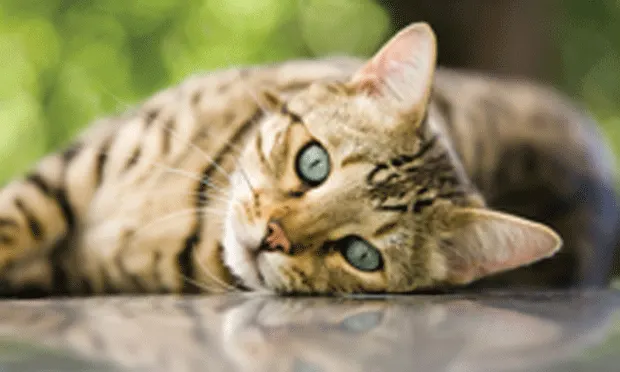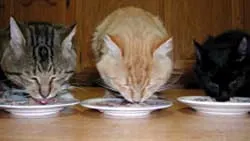Feline Retrovirus Infection
Katrin Hartmann, DrMedVet, DrHabil, DECVIM-CA (Internal Medicine), LMU of Munich, Munich, Germany

The decision to treat or euthanize a cat should not be based solely on the presence of retrovirus infection.
Cats infected with feline immunodeficiency virus (FIV) and feline leukemia virus (FeLV) are susceptible to the same diseases that occur in cats free of retrovirus infection, and many clinical signs found on examination may not be related to retrovirus infection.
In addition, retroviral testing can only diagnose infection, not clinical disease, and cats infected with FIV or FeLV may live for many years. However, FIV and FeLV status should be ascertained in all cats, healthy or sick, because the presence of retrovirus infection impacts their health status and long-term clinical management.
Management of FeLV & FIV
All cats in a household with a retrovirus-infected cat should be tested to determine their status. If positive and negative cats are identified in the same household, the owner must be informed of the potential danger to uninfected cats. Although the risk for transmission of FIV or FeLV is not high, the best method for preventing spread is to isolate the infected individuals and prevent them from interacting with housemates.
Update on FIV
FIV can cause an acquired immunodeficiency syndrome in cats comparable to human immunodeficiency virus (HIV) infection in humans and can lead to increased risk for opportunistic infections, neurologic diseases, and tumors. However, FIV does not cause a severe clinical syndrome in most naturally infected cats.
With proper care, FIV-infected cats can live many years and die from unrelated causes. Therefore, FIV infection has little impact on feline populations. Overall survival times are similar to those in uninfected cats, and quality of life is usually fairly high for many years.
Update on FeLV
FeLV is more pathogenic than FIV, and for many years it was considered a major cause of death in cats. This is no longer the case, as the prevalence and importance of FeLV have decreased. FeLV can cause variable clinical signs, including tumors, immunosuppression, hematologic disorders, and immune-mediated diseases.
Diseases secondary to immunosuppression account for many clinical signs in FeLV-infected cats, and it is important to consider that many of these diseases are treatable. The death rate in FeLV-infected cats in multicat households is approximately 50% in 2 years and 80% in 3 years. However, with proper care, an FeLV-infected indoor cat (single-cat household) may live much longer with good quality of life.

Multicat Households
FIV
FIV is mainly transmitted through biting
If social structures are harmonious in the household and no fighting occurs, FIV is unlikely to be transmitted
All cats in affected households should be spayed or neutered
No new cats should be introduced because of increased risk for biting
The benefit of vaccinating FIV-negative cats in such households is controversial
FeLV
FeLV is mainly transmitted through social contact but also through biting
If an FeLV-infected cat is identified in an otherwise uninfected household, other cats have most likely been in contact with the virus and are immune to new infection
The risk that adult FeLV-negative cats will become FeLV positive is approximately 10% to 15% if cats are living with a viremic cat
This is likely secondary to reactivation of latent FeLV infection and not by transmission from other cats in the household
If owners refuse or are unable to separate housemates, uninfected cats should be vaccinated against FeLV
Alert owners that vaccination does not provide high levels of protection in high-exposure environments
Individual Cats
FIV & FeLV: General measures
Affected cats must be kept strictly indoors to avoid transmission to other cats and prevent exposure of immunosuppressed cats to other infectious agents
Cats should be examined at least semiannually to detect changes in health status
Intact male and female cats should be spayed or neutered to reduce stress associated with estrus and mating behavior (ie, aggressiveness, roaming)
FIV & FeLV: Care & hospitalization
Surgery is generally well tolerated, but perioperative antibiotic administration should be used
Retrovirus-infected cats can be housed in individual cages in the same ward as otherhospitalized patients. They should not be placed in a “contagious ward” with cats suffering from other infections
If a cat becomes ill, prompt identification of secondary illness is essential to allow early therapeutic intervention
For medications, see sections on Antiviral Chemotherapy and Immunomodulatory Therapy in addition to Table 1 and Table 2
Most cats with retrovirus infection respond as well as uninfected cats do to appropriate medications for treating secondary infection, although a longer and more aggressive course of therapy (eg, antibiotics) may be required
Corticosteroids and other immunosuppressive or bone marrow–suppressive drugs should be avoided
Griseofulvin can cause bone marrowsuppression and should not be used
Filgrastim (granulocyte colony-stimulating factor, [G-CSF]) is contraindicated because it can lead to increased viral load
Erythropoietin and insulin-like growth factor 1 (IGF-1) can be used safely in FIV-infected cats
FIV: Additional measures
Secondary infection in FIV-infected cats can cause clinical signs of secondary disease and may lead to progression of FIV infection
When possible (ie, indoor-only adult cats), avoid vaccination
Vaccine-induced immunostimulation can lead to progression of FIV infection by altering the unstable balance between immune system and virus
Perform CBC, serum biochemistry profile, and urinalysis annually
FeLV: Additional measures
Routine vaccination programs should be maintained in FeLV-infected cats.
FeLV-infected cats may not be able to mount an adequate immune response to vaccination
Protection is not comparable with that of a healthy cat; therefore, more frequentvaccination (eg, semiannually) should be considered
Perform CBC semiannually; serum biochemistry profile and urinalysis annually
Treatment Protocols
Antiviral chemotherapy (Table 1)
Most antivirals used in cats are licensed for humans and are specifically intended for treatment of HIV infection
Some may be used to treat FIV infection because most enzymes present in FIV and HIV have similar sensitivities to various inhibitors
Nucleoside analogs are typically less effective against FeLV than against FIV, as FeLV is not as closely related to HIV
Few controlled studies about antivirals have been performed in cats, and multidrug protocols routinely used in HIV infection have not been studied at all
Many antiviral drugs are toxic and cause such events as myelosuppression
Antiviral drugs are currently only used in exceptional cases of FIV and FeLV infection
Immunomodulatory therapy (Table 2)
Some uncontrolled studies have suggested dramatic clinical improvement with immunomodulatory therapy, but these effects are typically not seen in controlled studies
Clear evidence of efficacy is lacking
Theoretically, immunomodulatory therapy may restore compromised immune function and allow patients to control viral burden and recover from the disease
There is no conclusive evidence from controlled studies
In FIV infection, nonspecific immune system stimulation may even be contraindicated, as it may lead to increased viral replication caused by activation of latently infected lymphocytes and macrophages
G-CSF = granulocyte colony-stimulating factor, IGF-1 = insulin-like growth factor 1
How I Treat FIV-Infected Cats
If no clinical signs are present
No treatment is indicated
Cat should be kept strictly indoors and should not be vaccinated
If clinical signs are present
Always look for underlying disease
FIV alone is typically not responsible for clinical signs
Treat underlying disease as indicated
FIV with stomatitis
Avoid use of glucocorticoids
I begin with azidothymidine (AZT) 5–10 mg/kg PO q12h (see Table 1) and antibiotics
If stomatitis persists, removal of all teeth (typically in 2 surgical events with total removal of all tooth roots confirmed by radiography) is recommended
FIV with neurologic signs
Look for any underlying disease responsible for neurologic signs
Treat underlying disease as indicated
If no underlying disease is present and neurologic signs are presumed to result from FIV infection, initiate treatment with AZT 5–10 mg/kg PO q12h (see Table 1)
FIV with recurring secondary infection
Treat recurring infection(s) aggressively (eg, long-term antibiotics)
Monitor virus load by quantitative RNA qPCR testing
Monitor CD4+ and CD8+ T-lymphocyte counts
If virus load is high and CD4+ T-lymphocyte counts are low, consider treatment with antivirals (eg, plerixafor 0.5 mg/kg SC q12h or AZT 5–10 mg/kg PO q12h; see Table 1)
AZT = azidothymidine; COP = cyclophosphamide, vincristine, prednisone; SPA = staphylococcal protein A
How I Treat FeLV-Infected Cats
If no clinical signs are present
No treatment is indicated
Cat should be kept strictly indoors
If clinical signs are present
Always look for underlying disease
FeLV alone is often not responsible for clinical signs
Treat underlying disease as indicated
FeLV with lymphoma
Initiate chemotherapeutic drug protocols (eg, COP [cyclophosphamide, vincristine, prednisone])
Discuss guarded prognosis with owners
FeLV with anemia
Look for underlying disease that may cause anemia (eg, lymphoma, myelodysplastic syndrome)
Treat underlying disease as indicated
Administer blood transfusions if severe anemia is present
Erythropoietin (100 IU/kg SC q48h; see Table 2) may be beneficial
If no effect, administer glucocorticoids Anemia in FeLV-infected cats may have an immune-mediated origin, so some cats may respond
FeLV with neurologic signs
Look for underlying disease (eg, lymphoma) responsible for neurologic signs
Treat underlying diseases as indicated
If no underlying disease is present and neurologic signs are assumed to result from FeLV infection, initiate treatment with AZT 5 mg/kg PO q12h (Table 1)
FeLV with recurring secondary infection
Treat recurring infections aggressively (eg, long-term antibiotics)
Consider treatment with immunomodulator (eg, feline interferon-W 106 IU/kg SC q24h or staphylococcal protein A [SPA] 10 µg/kg intraperitoneal injection twice weekly)